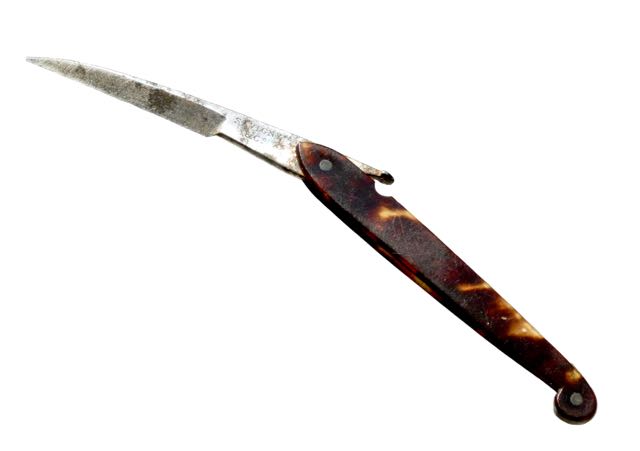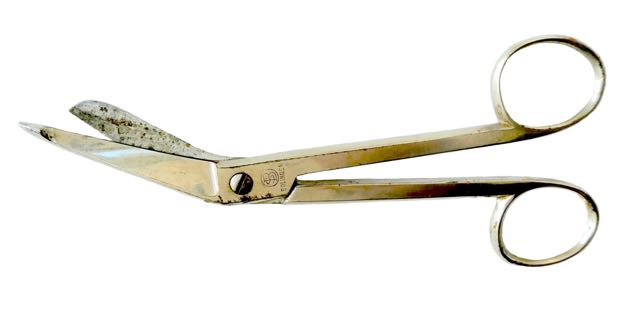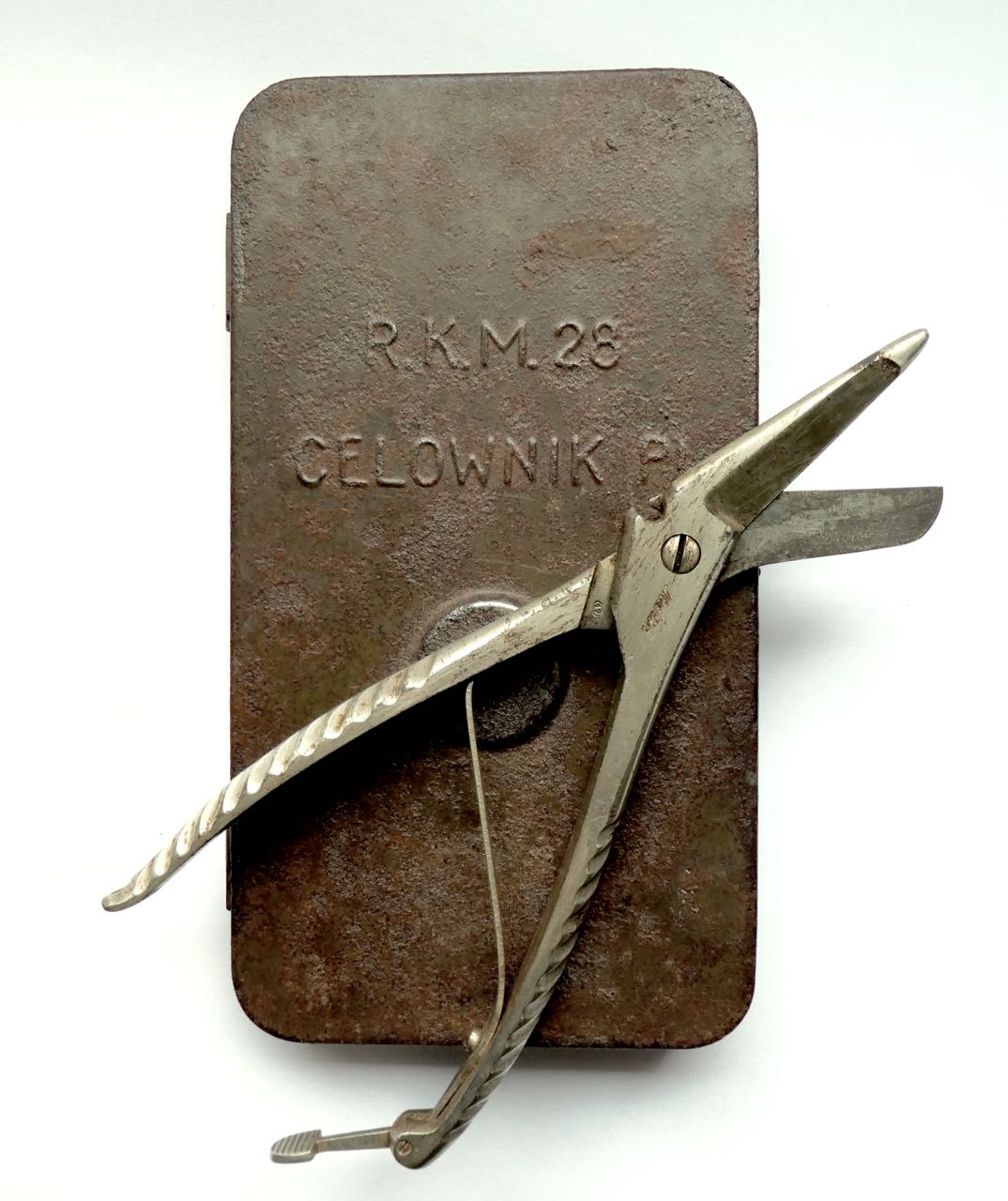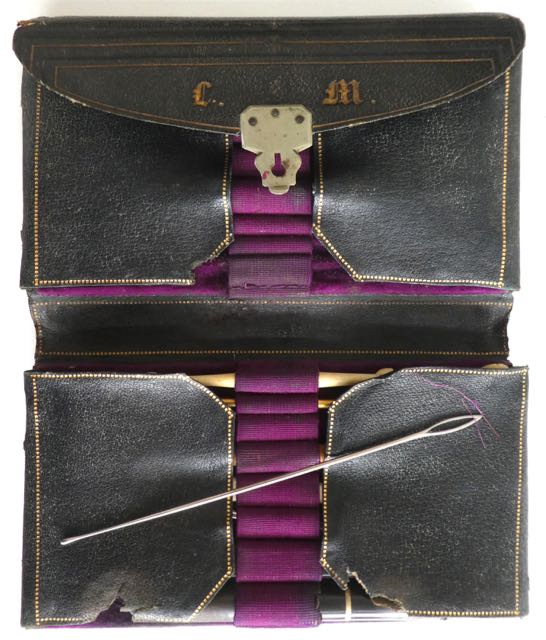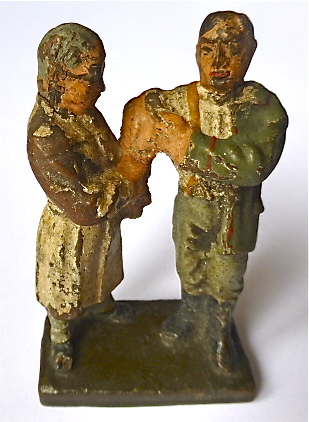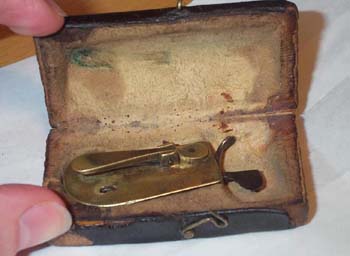Surgery |
||
Scalpel, surgical (2) |
||
"Bistouri, chirurgisches Messer mit einschlagbarer Klinge".
"En 1793, Joseph-Claude Récamier (1774-1852) est chirurgien auxiliaire de troisième classe dans le Service de Santé de l'armée des Alpes au siège de Lyon. Il s'embarque ensuite sur le vaisseau "ça-ira", puis s'installe à Paris. Là, il établit les leçons cliniques à l'Hôtel-Dieu. Il invente un bistouris à monture très simple, qui, en s'ouvrant, devient scalpel" (zit.: Musée Laennec/Paris). With this remark we enter into the controversy around the terms Scalpel / Bistouri. We found the following clarification on the internet:
The Bistouri is used to cut skin and muscles |
Surgery |
||
Scalpel, surgical (3) |
||
Skalpelle der besonderen Art findet man in Präparierkästen, die in anatomischen Prosekturen und in Studentenkursen benutzt werden: die Skalpelle haben eine feststehende Klinge, der Griff ist z.T. als Schaber zu benutzen, mit dem anatomische Schichten freigelegt werden. |
Surgery |
||
Scalpel, surgical (4) |
||
Two scalpels with fixed knife, around 1960 |
Surgery |
||
Scalpel, surgical (5) |
||
Surgical knife with foldable blade. Parts: Handle and blade (French chasse, lame, English handle, blade).
Bistouri by the English manufacturer John Honoré SAVIGNY, 1820-50. Length unfolded 13.9 cm; closed 9.0 cm; Width 1.1 cm; Thickness 0.4 cm. Placing the blade in a 2 mm round recess on the handle, no latching. Therefore, dating to the 1st to the early 2nd third of the 19th century Length of the blade 7,8 cm. Length of sharpened blade 4.1 cm Tortoiseshell straight bistouri scalpel circa 1830/40. Blade is not locking; maker marked. Origin: Sofia / Bulgaria
The bistouri traces back to the early days of English surgery: John ABERNETHY (1764-1831), who invented a digestive biscuit, Astley Paston COOPER (1768-1841), who first stopped the abdominal aorta, James SYME (1799-1870), the He invented new amputation techniques - he was the first to drop a leg in his hip in Scotland. His daughter Agnes (1834-1893) married the great surgeon Joseph Lister (1827-1912). We owe Lister that surgical intervention can be a humanly safe treatment. Before he set up his "antiseptic principle" in 1867, even the smallest operation was associated with a mortal danger. Sepsis did not always occur, but the constant uncertainty about the outcome of surgical treatment was even more distressing to Lister's contemporaries when the discovery of ether anesthesia (1846) and chloroform anesthesia (1847) gave them the opportunity to operate painlessly. One could venture larger interventions and was no longer as under pressure as the surgeons of the 18th and early 19th century. At that time one leg was amputated in 30 seconds! It was precisely this easing of the operation that increased the risk of infection: the longer the surgeon tampered with his fingers, his instruments and sponges in the patient's body, the less the infection could be avoided, the more frequently septic death occurred. Since one did not know the true cause - the transmission of bacteria as germs of disease - one sought the reason for it in unfavorable influences of the soil or the air (Miasmen), in the bad constitution or the unstable condition of the sick. But also the narrowness and uncleanliness of the hospitals was an issue. |
Surgery |
||
Scissors for bandage (1) by LISTER |
||
John Lister (1827-1912) worked as a professor in Glasgow and London. He gained special importance through his investigations on wound healing. While it had previously come to life-threatening infections even with small interventions, now the antisepsis was established. This was closely linked to the development of microbiology, for example through the investigations of Louis Pasteur. Lister is considered together with Ignaz Semmelweis as the founder of hospital hygiene. The spraying of phenol over the field of operation to kill bacteria has also been termed "listern".
The "father of antiseptic surgery" was also inventor. He set an important milestone in wound treatment in 1874 with the invention of the first germ-free dressing. He already knew from reports that the phenol known as carbolic acid could kill germs. Lister came up with the idea to use Phenol also in disinfection operations, he had the liquid over the surgical field fogged and the Chirirugen and sisters washed their hands with it. A little later, he also started to provide wounds with phenolic-impregnated dressings. This Listersche association killed germs and thus made a quick and uncomplicated healing possible. Matching with this association, he invented the named after him scissors.
The Lister'schere consists of surgical matt stainless steel and is stainless. As a result, it is not only particularly robust and durable, but can also be sterilized and disinfected. The sharp blade is angled at this bandage scissors and allows the severing of bandages without much effort. In addition, the bandage scissors (Lister scissors) has a knee bend, i. the blade is angled upwards and flattened at the bottom of the tip. Thus, the Lister'schere can be pushed without risk of injury to the patient easily under the dressing and provides a simple way of painless treatment.
Exhibit 16 cm long bandage scissors by LISTER from the pool of a general practitioner in Hall (Flea Market Hafen / Innsbruck 9/2018).
About the manufacturer: In 1998, Bergische Stahlwarenfabrik (BS) celebrated its 75th anniversary as a world-renowned manufacturer of Solingen quality steel products. BS-Stahlwarenfabrik Spiecker & Söhne e.K. |
Surgery |
||
Scissors for bandage (2) by MARTIN |
||
Bandage scissors are characterized by their blunt tip, which allows the surgeon to introduce them under embedded and encrusted bandages without injuring the skin.
Exhibit The scissors shown here were made in the workshops of MARTIN and found themselves on a Luxembourg flea market, along with the metal box on which it is now pictured. This turned out to be a container for the target of a Polish military machine gun - and was not, as originally thought, a surgical cutlery box. Apparently he found his way to Luxembourg as a container for the scissors ... The company "Gebrüder Martin" was founded in 1923 in Tuttlingen as a joint sales subsidiary of seven competing (!) Partners (see under "Suture cutters").
As a special feature I would like to emphasize the wire cutters: near the joint, they had a considerable biting power. Otherwise, the scissors are still found today in the catalog of Fa. Martin again. |
Surgery |
||
Scissors for plaster by STILLE |
||
Since prehistoric times, wooden rails have been known in association with other thermosetting materials, such as e.g. Clay or clay. Apparently, the hardening bandage was already known to the great medieval surgeon RHAZES - he described associations of clay with added protein, which he not only described but also used. The durability of these materials left much to be desired.
Plaster scissors
|
Surgery |
||
Seton needle |
||
Already the Alexandrian school used a cinnamon, with a leather probe to be ligured. Evender, hair line (latte. The French name "Séton" comes from the Latin "SETA" for the pork offices. In fact, the first surgeons pork offs put in the wounds to facilitate the tire. Their successors used the longer horse hatches, the successor cotton threads - already 1370 voice guy de chauliac from the Céton as a "Mèche de Coton Passée à Travers la peau Pour endurance un-outreire" (la Grande surgery [trad. You Lat.] D'Apr. Sigurs, p. 74).
You said: Place a stylish or stick a hair rope. The hair rope was a rope hat-row made roded through the skin to await an artificial ulcer; In particular, it was applied to the eye disease and victimpse from the 16th to the 19th century. The patient has raised a piece of neck skin with a hair cable. But it also went without pliers: After the surgeon had turned the skin in herself, he formed a lease, one of which had a handle over a while, while he held the other with the left hand himself. To the technique After a race has stroke a channel with a bistyi between the two handling, the surgeon led a stileter with an oex (eye), in which a wieke (threads) was threaded, on the blade through the continuity solution and the threads (or the likes) in it back. Through the two skin cuttings, a hair rope needle was passed through the hair rope, a string hair bubble, canvas or the like. The hair rope remained under the skin for several days until it tapes. This extension should now contribute to the "derivation of bad juices" from the rest of the body. "The name is given to the same way to the same for the old pure the same horsehaire. The linen strips slightly slightly under a skin bridge, which must be at most a customs wide, but must be blended against two foot, is attached to a derived association. If the finger has occurred, the association is renewed once a day or more often and, in the every later renewal, the extinction of the linen strip, which was pulled out and made of this lined solid, but this, but reappeared and again, which is attached to the hair rope, one chooses different areas of the body. The most commonly manages to be in the neck, but also on the chest, in the liver and gastric area, on the abdomen, on the thighs and the gastric area, on the abdomen, on the thighs u ..S. It is found in a large number, natively, the likewise, disease conditions, it is in a large number, natively, dangerous, disease conditions, and is sometimes awarded, with a narrow, disease conditions, and is sometimes awarded from excellent healing effects. So it has recommended it in some brain denominations; We have excellently in stubborn eye and ears in influences, with effluents from the ears, lung seeds u ..sw. More commonly is his application in thier casting "(Brockhaus Pictures conversations Lexicon, 1st edition, Leipzig: F. A. Brockhaus, 1837 - 1841).
Indications "Hair rope (setaceum), a formerly horror, manufactured now, castors od. Silk also linen cord, od. A ribbon made of canvas, od. A pinion frade pointed on the sides. You need to get an artificial ulcer. One suffers a sufficiently width needle (hair silence), in which the epiralized with the digesty-essent H. is introduced, in a for this purpose with the finger OD. A suitable tongue (hair rope pliers), the pond of the skin, then pulls the hair rope and leaves now in the wound, where soon a significant deduction forms, which is that the H. posts twice daily after the day. Ehdem was pleased with Lungen- u. Heart-dies, heavy literacy, especially as with brain- u. Optical events as the salvatate drainage means; Now it is pretty use, unally with thierte doctors. In addition, it also served a mastery by dinger to decrease od. To destroy, even to make channels to be able to do so. Then it is introduced by this with the hair rope needle. id. A stilet. In those interested, when a nodes (drain belt, drainage), which is unprecedented with ointment, so that the evil juices of a sick of the part, "from the purpose of a silent" wrapping "(Pierer's universal lexicon, altenburg, 4th edition 1857-1865). - Fabricius Hildanus (1560-1634) reported over two cases of epilepsy, where all other means had failed. He healled themselves by creating a hair rope in the neck. The French clinician Lazarus Riverius (1589-1655) reports in his" practice Medica "about healing epilepsy by hair rope and catering. - Very distributed was the application of the hair rope in rational tubular impressions. Expressively, it was also the same as the very sensitive physicians of the 16th, 17th and 18th century Generally considered very effective recommended and applied. There is still a similarly described in the 1866 August is still in the 1826 released novel of Wilhelm Hauff" The man in the moon ", where a lung disease is a brand of a cheese apart from the Warhelm Hauff" The man in the moon "where a lung disk is a brand of a cheese on the chest of a miserable. "If no hair-wire needle is handled, the skin folders can be treated with a lancet and the thread can be introduced with a probe (p.176). The French were so familiar with the use of hair seals, that they not only limited it to meat, but siesogar by the thorax, the abdomen and the knee joint" (Samuel Cooper, newest manual of surgery in alphabetical order, band 3, 1821 p546).
Summary In the oehr a rope was threaded. Then the skin of the neck was cut in two places and the needle passed through the skin in the skin. The rope bound out of the needle in the wound remained in the wound over several days - it came to a (unwind) extension that distinguishes another (unwanted) extension (in eye, ear or brain) "except" - a common treatment in the 16th to 19th century! Exponat Trousse of the Farm Factory Mathieu, there a 14 cm long needle probe with a particularly great oeh. "The needle probe or Oehr probe has a long-term oex in their thicker end, which convey hair hair or thread by wounds or fisteles" (Julius Leo, Instrumentarium Surgical, Berlin 1824 p3). Manufacturer: Louis Mathieu (1817-1879) |
Surgery |
||
Soldier, vaccination |
||
After the discovery of the principle, the industrial production of tetanus antitoxin (also called tetanus serum) was recorded from about 1896. Therefore, at the outbreak of the war in 1914 there was not enough serum, and from August to December 1914 there were 3.8% of the approximately 400,000 wounded with tetanus (the same percentage as in the war of 1870/71). From January 1915 all wounded could be supplied with serum, whereupon the tetanus diseases dropped to 0.4 per thousand.
Presented is a 7 cm high group of figures of the German company "LINEOL GERMANY". which is often referred to as a "doctor examines arm". Since there are no traces of blood on the arm, and the patient is shown standing, it should not be an injury, but a vaccine, especially since the soldier has not even taken off the jacket that hangs casually over the left shoulder.
Oskar Wilhelm Wiederholz (1877-1955) experimented from about 1903 on a material that was to be suitable for the industrial production of toy figures. The invented by him "mass" consisted of wood flour, chalk, linseed oil and bone glue and was hot pressed into metal molds. His invention he called Lineol. In 1906 he founded a.d. Havel the Lineol AG. Military vehicles were soon missing under no Christmas tree; the companies Elastolin / Max Hausser and Lineol / Wiederholz produced whole soldier regiments and military vehicles of the highest quality.
Two vaccinations were common in the German Army in 1914: - the vaccine against cholera, which was often done on the eastern front. - vaccination against tetanus. |
Surgery |
||
Anal speculum |
||
In endoscopy, the areas of activity of the surgeons and internists overlap. It's not up to me to decide who owns which part.
The fact is that colonoscopy is one of the earliest "insights" inside the human body. Even the heavy Roman specula were probably used not only to see the female vagina, but also to inspect the rectum. The rectal speculum has proven itself to visit the lower rectal and rectal anal sections.
Two nearly identical anuscopes are presented , both according to Dr. med. BENSAUDE: the left with the round, fluted handle of SIMAL company, the right one with an octagonal handle. The useful length was just 6.5 cm for both devices. After BENSAUDE is named a method for the sclerosis of anal fissures .
The KELLY proctoscope, developed in 1895, can be inserted up to a depth of 20 cm. |
Surgery |
||
Compressed sponge |
||
I In pharmacies you could by sponge cuts soaked with molten wax and pressed under the name press sponge (Spongia cerata) - already the royal Prussian Medicinal constitution of 1818 knew the wax sponge. Today is the trade in these sponges [Spongia officinalis adriatica (Schmidt, 1862); Spongia officinalis officinalis (Linnaeus, 1759)].
Manufacturing Spongia cerata was prepared by dipping cleaned and dry sponge pieces in melted wax and pressing weakly between slightly moistened boards. Spongiae compressae are produced by squeezing fine, clean, moist pieces of sponges with string or wrapping them in glass tubes and allowing them to dry. "The spongia compressa seu praeparata is prepared by cutting elongated pieces of cleaned sea-sponge, moistening them with hot water, and wrapping them tightly with a thin string from end to end." It is also necessary to moisten the sponge before wrapping with a dissolution of Only when this prepared sponge is to be used is the twine unwound "(Ernst Blasius, Handwritten Book of All-Surgical Surgery and Ophthalmology: for Use by Future Physicians and Surgeons, Berlin 1838 p.398) ). It is used to form damp, finger-length pieces of cleaned sponges about 3 cm wide by means of strong lacing with twine in the thickness of a leaden lead, dried and stored in this wrapper, and after removal of the cord, used to dilate the sponge Wound ducts "(Gustav Adolf Buchheister, Verlag von Julius Springer, Berlin, 3rd edition, 1893 p. 343).
Application In the past, laminaria stems, tupelo wood or gentian root were used to dilate wound channels. Particularly frequently one used compressed sponges. "They serve, after removal of the cord, for the widening of wound channels" (Gustav Adolf Buchheister, publishing house of Julius Springer, Berlin, 3rd edition, 1893 P. 343). There were also unconventional applications: - the Austrian "academic regimental physician" Johann-Georg Schwarzott used it in 1820 to compress an insatiable bleeding in the area of a lower leg - the bleeding stopped within 2 minutes. On the third day the sponge was removed without any bleeding (Medicinisch-chirurgische Zeitung, Salzburg 1820 p. 46). Kluge (L. Mende, Observations and Remarks, vol. 3, 1826, pp. 26-50) introduced preterm birth by introducing a pressure sponge into the cervix (Adolph Carl Peter Calisien, Medicinisches Lexikon p. 217). Around 1900, the press sponges were rarely used (Gustav Adolf Buchheister, published by Julius Springer, Berlin, 3rd edition, 1893, p. 343).
Geschenk von Mag.Dr. Andreas Winkler - mein Dank! |
Surgery |
||
Spring lancet (1) |
||
"Blood is a very special juice" - said Mephisto in 1808.
Charlatans used human and animal blood for their healing maneuvers: "If you cut a hole in the ear of a very black cat and let the drops of their blood run on a piece of bread and eat it, it will help against the fever".
Since antiquity, people are being blunted for a variety of reasons: high pressure, recognizable by the bright red head, internal poisoning by a bad mixture of the four cardinal juices. In the Middle Ages, Bader was responsible for the bloodletting, a craft guild responsible for haircuts and shaving, but also for minor operations and teeth removal. They used Aderlassmesser, so-called Flieten, with which they opened the blood vessels. This usually caused large wounds, because at the time, little was known about the course of the vessels.
The first cupping lancets were developed in the 15th century to make it easier to score the skin faster and thus painlessly. The Schnepper experienced their widest distribution in the 19th century. "In the 18th century, the use of Aderlassschnäpper was often used instead of the knife, a feather catapulting a small knife out of it.The pathological-anatomical Federal Museum in the Fool's Tower naturally also has some of these" modern "aids from the 18th and 19th centuries. The blood spurting from the vein was collected in a veined vial, usually decorated with pious motifs, measured the amount and judged according to various criteria such as color and coagulation ability to obtain indications for additional therapies. "Now as soon as the rotting with the blood is drained, followed by pure blood, and then you have to stop bleeding. "However, Hildegard von Bilgen's advice often does not seem to have been followed, or simply, there was no pure blood. Assuming a total volume of 24 liters of blood, one hardly knew restraint during the bloodletting "(PHARMACY WEEK).
The catch consisted of flexible, razor-sharp blades of 5 - 7.6 cm in length in folding sheaths made of ivory, tortoiseshell or mother of pearl. Shape and size seem to have changed little over time. In the early 19th century, the "automatic catch" was invented, a type of syringe whose head was jounced into the vein with a spring.
Exhibit Presented is a simple model without decoration, on the lid of the original box is in old German letters |







